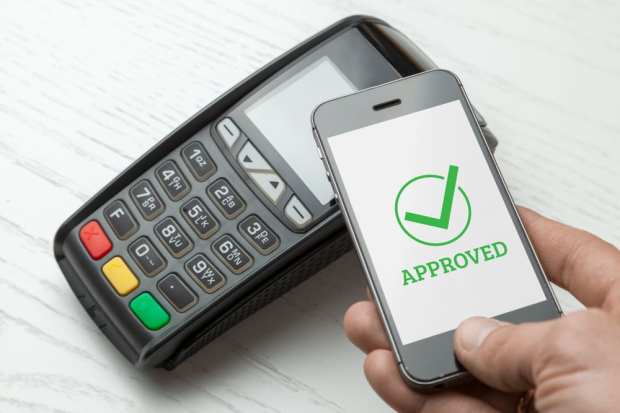POS Payments At The Speed Of Sound (Waves)

Friction bedevils all types of retail — and that holds true for transactions inside stores or via eCommerce sites. At the same time, the ongoing effort to create true omnichannel experiences for consumers often runs into roadblocks of friction, frustrating merchants and consumers alike.
That being obvious doesn’t make it any less true — or any less meaningful to those involved in payments and commerce. However, there is a growing hope that sound — yes, sound — can help solve the friction problem, promote omnichannel efforts and even reduce payment costs for merchants.
That’s the story told by LISNR CCO and Co-founder Rodney Williams during a recent PYMNTS interview with Karen Webster. LISNR sells pay-by-sound technology that requires no point-of-sale (POS) upgrades, which can help merchants better replicate seamless eCommerce experiences inside brick-and-mortar stores. LISNR is taking part in the METRO Target Retail Accelerator, certified by Techstars. That’s a mouthful, but it means LISNR, which sells ultrasonic-sound transmission technology for use in retail and payments, gets an opportunity for an innovation boost, alongside retail leaders from around the world.
Solving For Friction
Friction is never an easy problem for which to solve, but increasing consumer demands and expectations set by online and mobile commerce — quick shipments, ample recommendations and other features — mean the bar keeps rising for retailers interested in better omnichannel commerce, Williams said. Not only that, but history, in a sense, is catching up with retail.
“eCommerce was the bad stepchild of retailers,” he told Webster. “It used to be a separate entity of an organization,” and retailers acted accordingly, often building separate systems for brick-and-mortar and online commerce. Retailers, as a whole, though, didn’t anticipate the rise of mobile commerce, payments and shopping.
The legacy of such divisions endures today, creating fault lines and other places where the seamless, friction-free omnichannel ideal tends to break down — a problem that puts further pressure on brick-and-mortar operations. “That’s probably why it’s taking so long,” Williams said, talking about the persistent problem of friction.
So, what on earth does sound have to do with a possible remedy?
Well, the idea is to take advantage of the speakers that retailers already have in their POS systems. LISNR purposely built its capabilities on software, rather than hardware, to make it more compatible and scalable. As LISNR does it, pay-by-sound uses an advanced, ultra-low power, wireless-transmission technology to transmit data via sound waves, which originate from the same POS terminals that retailers already use. Any mobile phone can pick up or send those waves to complete a transaction, as long as it has an app installed that utilizes LISNR’s software development kit (SDK). No special features need to be present or enabled — unlike near-field communication (NFC), which only functions on certain phones.
Card-Present Transactions
That technology can enable seamless payments inside stores — and potentially at card-present rates, which saves merchants money over the fees charged for card-not-present transactions. This is a major feat exclusive to LISNR’s technology. Such technology reflects a trend in the wider world of retail and payments, in which various types of wireless communication are used to broaden and deepen the customer experience, and give merchants — inside stores, as well as via online and mobile channels — more capability to serve customers on their own terms.
Even though most retail purchases still take place inside physical stores, consumers are in an eCommerce mindset — and that applies to payments, which have, over the past decade or more, shifted from a sleepy island of activity to a center of innovation and importance. “eCommerce is all about ‘buy now,’” Williams said, touting one of the main benefits of the pay-by-sound technology, which doesn’t rely on terminals or scanners placed throughout a store.
“Everything in a store is a ‘buy now’ moment,” he said, if one thinks of it via the viewpoint of eCommerce. As for such omnichannel-promoting tools, “retailers are screaming for it.” That point was bolstered by recent PYMNTS coverage of omnichannel, and how the word has changed in meaning since the dawn of online retail — it now tends to describe the process of further blurring the lines between eCommerce and offline retail.
In part, such technologies are designed to rebuild the egg that was shattered with the rise of online retail. Stores used to be the single location where shopping, payments and fulfillment happened. Yet, with eCommerce, those tasks have become disparate — and opportunities for innovation have emerged for new forms of payment.
In addition, “retailers today are learning that [consumer] data is probably the most important part of building any omnichannel experience,” Williams told Webster. That means retailers need to own their transaction experiences — the more seamless (theoretically, at least), the more places they can drive a transaction, and the more they can collect better data.
For now, the pay-by-sound technology is finding most of its use in mass market retail within the U.S. and Europe, Williams said, though he anticipated more pickup from the quick-service restaurant (QSR) segment (itself a hotbed of digital innovation, as PYMNTS research has regularly demonstrated). Pay-by-sound still has a long way to go before capturing more mainstream consumer and retail acceptance, but it stands as an example of how the current push toward omnichannel could spark more innovation.
